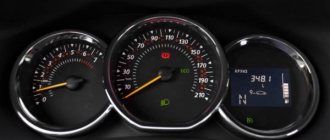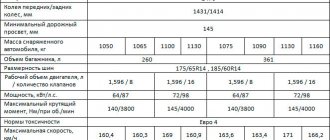Fuel consumption indicators for different engines: norm and real data
How much the machine should “eat” according to the norm is stated in the technical documents. But in fact, the real numbers are always different. This difference is made up of the following factors:
- vehicle weight;
- engine capacity;
- driving style;
- driving conditions: highway or city;
- drive unit.
It is important to note that the passport standard is practically unattainable. A positive option for any car is when the car consumes no more than 10-15% more than what is indicated in the documentation per hundred kilometers.
Lada Vesta VAZ-21129 (1.6)
The initial and most popular type of engine for the Lada Vesta is a 1.6 liter 106 horsepower engine with 10 valves. There are two options for such models: they can be equipped with both mechanics and automatic transmission. This will significantly affect fuel costs. The official website contains standards that have been tested in laboratory conditions and are not related to operational figures. In practice, these figures are always slightly higher.
With engine 1.6 manual
The consumption standards for a manual gearbox in the car's passport are as follows:
- for driving in urban areas – 9.4 liters per hundred km;
- for driving on a flat country road – 5.7 liters for the same distance;
- when mixing driving cycles - 6.8 liters.
In reality, indicators for mechanics:
- driving in urban areas - 10.4 liters;
- on a country road - 6.4 l;
- when mixing driving types - 8.1 liters.
If the driver is accustomed to smooth control, then the fuel cost parameters will always be slightly lower than when driving with constant braking and a sharp start.
With engine 1.6 Robot
Costs, both standard and actual, are slightly lower with automation. Passport indicators:
- urban conditions - 8.9 liters per 100 km;
- road outside the city – 5.3;
- when mixed - 6.6 l.
Real figures: for the city 9.9 liters, for the highway - 6.2 liters, and with mixed driving - 7.5 liters.
This is with good driving, without taking into account additional factors. On average, Lada Vesta “eats” 8–10 liters per 100 km with a 1.6 engine.
Owner reviews about fuel consumption of Lada Vesta 1.6 106
Lada Vesta VAZ-21179 (1.8)
The VAZ-21179 engine was released recently, and it powers the station wagon. Engine indicators:
- 1.8 liters;
- power parameters – 122.5 horsepower;
- 4 cylinders;
- compression level – 9.
When moving around the city, the maximum consumption for such an engine is 11 liters per hundred km. But the details also depend on the gearbox.
With 1.8 manual engine
Indicators for mechanics according to the passport:
- in the city - 11 liters;
- outside the city – 6 l;
- mixed driving – 7 l.
In reality, a manual with such an engine consumes from 8–12 liters, depending on driving conditions.
With engine 1.8 Robot
The machine spends less:
- in the city - 10 l;
- outside urban conditions – 5.5;
- mixed driving – 6.5.
In fact, the figures range from 7 to 11 liters per 100 km.
Owner reviews about fuel consumption of Lada Vesta 1.8
Lada Vesta HR16DE (1.6)
The foreign version of the 1.6 liter engine has 117 horses. With the same volume as the VAZ-21129, the foreign engine has more power. They are not adapted for automatic, there is only a mechanical option. Standard fuel consumption indicators for this engine:
- in the city - 8 liters per 100 km;
- on the highway - 5 liters per 100 km;
- with mixed driving – 6 liters per 100 km.
In fact, the Lada Vesta HR16DE consumes 6–9 liters. It is permissible to refuel such a car with methane, which is much cheaper in terms of costs.
Engine 21124 (16 valves, 1.6 mt 90 hp)
Starting from 2009, 16-valve engines began to be installed in the “four”. The first variation with a gearbox from Super-Auto was released in 2009. From this moment on, the model received a second life, because more technologically advanced and dynamic engines combined with the lightweight body of the “fourteenth” went well together. At the same time, the fuel consumption on the 124th engine has changed slightly:
- City mode on the 124 engine “eats” 8.2 liters per hundred kilometers of road. Compared to earlier 8-valve engines, the “gluttony” indicator has decreased by almost two liters of fuel;
- When driving on the highway, the figure is about 7.2 liters, but according to the plant. In practice, this figure varies from 5.8 to 8;
- Average mode – 7.6-7.8.
Consumption in the city in winter is close to 11 liters. The average fuel consumption rate on a 124 engine is about 7 liters in fact. Maximum efficiency is achieved at a speed of 100-110 kilometers per hour in 5th gear.
Statistics of fuel consumption on different Lada Vesta models
Lada Vesta has a number of different models. Depending on the configuration and the vehicle itself, the average fuel consumption figures also change.
| Lada Vesta model | Fuel consumption, l/100 km | |
| Document costs | Real numbers | |
| SW 1.6 | 5.7-9.2 | 6.5-10 |
| Cross Lux | 8-11 | 8.5-12 |
| SV Cross | 7.4-10.7 | 8-11.5 |
| SV 1.8 | 6-10 | 7-11 |
Speed sensor
Also, the cause of high fuel consumption per 100 km (VAZ-2114) may be the speed sensor. Its main task is to transmit information about the speed of the vehicle to the control unit. The latter monitors the operation of the engine by adjusting the throttle valve. The problem with this sensor will be shown by the on-board computer or error reading device. It is almost impossible to replace it yourself without specialized knowledge. Typical symptoms of speed sensor failure:
- Speedometer failure or interruptions.
- “Floating” idle speed.
- Noticeable loss of traction.
- Stopping the engine when idling.
- Increased gasoline consumption.
Reasons for high gas consumption
If fuel consumption differs from the passport values by more than 30%, you need to go for diagnostics. There may be several reasons for increased fuel costs:
- Incorrect, too harsh driving style, with sharp braking and instant acceleration.
- Poor quality gasoline.
- Poor performance of the power unit and its components.
- Negative temperatures, driving on winter roads.
- Constant operation of the heater, air conditioner and other devices in the cabin.
If you operate the car correctly, you can get as close as possible to the indicators that are in the documents.
Simple reasons that you can eliminate yourself
Sometimes you can solve the problem of the huge fuel consumption of the VAZ-2114 yourself. First of all, you need to check the degree of contamination of the fuel filter and check it for debris. If there is debris inside it or suspicion of contamination, then it is better to replace it. This element is inexpensive, and its average price is 300 rubles. You can replace it yourself - it’s simple and does not require the intervention of a specialist.
The second filter is the air filter. Air passes through it, which is subsequently mixed with gasoline and supplied to the combustion chamber. And if it is dirty, it will not be able to pass enough air. As a result, the air-fuel mixture will not be enriched with oxygen, and a lean fuel mixture will quite logically lead to increased gasoline consumption. Car owners often manage to reduce gasoline consumption by approximately 3 liters per 100 kilometers simply by replacing the air filter. It is easy to change - it is located in a large black box under the hood.
How to reduce fuel consumption on Lada Vesta
To reduce fuel consumption, first of all, you should regularly carry out diagnostics and repairs for the engine. There are other ways to reduce the “appetite” of a car:
- reduce overload by removing all unnecessary things from the cabin;
- Check tire pressure regularly and reset excess tires;
- In order to be able to track costs, you need to regularly update the meters and clean the fuel system of the power unit.
If costs have increased by large amounts (more than 30% of the norm), you need to contact specialists and check all components of the fuel system. It is not always possible to do this on your own, so it is better to turn to professionals.
Increased consumption in idle mode
Typically, normal gasoline consumption when the engine is idling is 0.8-1 liter per hour. If these indicators are not exceeded, it means that everything is fine with the system. If consumption is increased, then it is worth checking the same sensors. However, special attention should be paid to the idle speed sensor, which automatically regulates idle speed. It is located on the throttle assembly and is secured with a pair of screws. The device does not have an electronic system, so its breakdown will not be displayed on the dashboard in the form of a “check”. You can judge its malfunction only by certain signs:
- Lack of high speed when starting a cold engine.
- The engine stalls when idling. This may even occur during gear changes.
- “Floating” idle speed.
Video: comparison of gasoline consumption 92 vs 95
Let's compare what is more profitable for the Lada Vesta - refueling with 92 or 95 gasoline? It is clear that quantitative consumption indicators when using 95 are preferable: 11.7 l/100 km compared to 12.4 l/100 km when refueling AI-92. What about finances?
Data for calculation:
- consumption indicators with video (movement without traffic jams);
- gasoline prices as of 06/08/2019 from Lukoil (since, according to our survey, this is the most popular network of gas stations), Moscow.
| Type of fuel | Comparison of fuel consumption and costs | |
| AI-92 | 95 euros | |
| Price (Lukoil) | 44.64 rub. | 47.28 rub. |
| Consumption | 12.4 l/100 km | 11.7 l/100 km |
| Expenses | 537.2 rub/100 km | 542.3 rub/100 km |
How correct the figures turned out is up to you to judge; in any case, you will have your own indicators and prices. The purpose of this comparison is to show that it is worth paying attention not only to fuel consumption, but also to financial costs. Particularly corrosive ones will talk about depreciation, wear and bad fuel, but that’s a completely different story.
Fuel consumption is a sore subject for any motorist. The real price of car servicing depends on this indicator. But passport characteristics always differ from reality. The same model with the same configuration can change fuel consumption figures for different owners. It all depends on driving conditions and driving style. Even a working air conditioner in the cabin increases the “appetite”. Therefore, when car costs increase by a large figure, it is recommended to carry out diagnostics from specialists and identify the cause. If everything is in order from a technical point of view, pay attention to the weight of unnecessary items in the cabin and the smoothness of driving.
Lambda probe
One of the first and most important sensors, the operation of which can affect increased gasoline consumption, is the lambda probe. It is located on the exhaust pipe, and its main task is to assess the condition of the exhaust gases. Based on the oxygen content in the exhaust, the system regulates the volume of the working mixture. Accordingly, if the sensor malfunctions, the system will not be able to accurately regulate the working mixture that needs to be supplied to the combustion chambers. This may increase consumption.
However, if the sensor breaks down, the system warns the driver about this with a “Check” light on the dashboard. You can also see the error using the on-board computer. Often this sensor breaks down due to poor quality gasoline, oil getting into the combustion chamber, or valve clamping.










